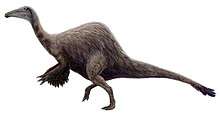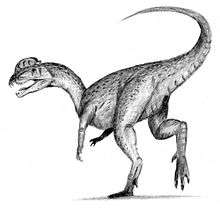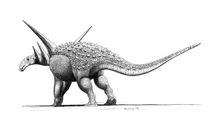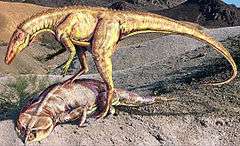1970 in paleontology
Paleontology or palaeontology is the study of prehistoric life forms on Earth through the examination of plant and animal fossils.[1] This includes the study of body fossils, tracks (ichnites), burrows, cast-off parts, fossilised feces (coprolites), palynomorphs and chemical residues. Because humans have encountered fossils for millennia, paleontology has a long history both before and after becoming formalized as a science. This article records significant discoveries and events related to paleontology that occurred or were published in the year 1970.
| |||
|---|---|---|---|
Arthropods
Newly named insects
| Name | Novelty | Status | Authors | Age | Unit | Location | Notes | Images |
|---|---|---|---|---|---|---|---|---|
|
Sp nov |
Valid |
Fujiyama |
Chojabaru Formation |
A myrmicin ant |
||||
|
Fam nov |
nomen nudum |
Florissant Formation |
A scorpionfly family, type sp. H. maculosa |
|||||
Archosauromorphs
Newly named diapsids
| Name | Novelty | Status | Authors | Age | Location | Notes | Images |
|---|---|---|---|---|---|---|---|
|
fam et gen et sp nov |
valid |
possible gliding reptile covered with Feather-like Scales. |
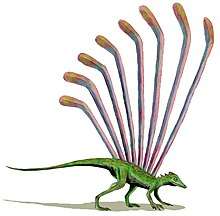 Longisquama insignis | ||||
Newly named dinosaurs
Data courtesy of George Olshevsky's dinosaur genera list.[5]
| Name | Novelty | Status | Authors | Age | Unit | Location | Notes | Images |
|---|---|---|---|---|---|---|---|---|
|
gen et sp nov |
Valid |
Russell |
A tyrannosaurine tyrannosaurid. |
| ||||
|
fam, gen et sp nov |
Valid |
Osmólska & Roniewicz |
| |||||
|
gen nov |
Valid |
Welles |
Kayenta formation |
A Two-crested Dilophosaur. |
| |||
|
"Likhoelesaurus"[9] |
gen et sp nov |
Ellenberger |
Lower Elliot Formation |
Misidentified non-dinosaurian archosaur. |
||||
|
gen et sp nov |
Chimera of Deinonychus and Microvenator. |
|||||||
|
gen et sp nov |
Valid |
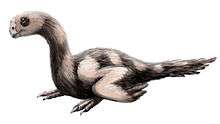 Microvenator celer | ||||||
|
gen et sp nov |
Valid |
| ||||||
|
gen et sp nov |
Valid |
| ||||||
|
gen et sp nov |
Valid |
an ornithopod. with a Long Tail. |
| |||||
Newly named birds
| Name | Novelty | Status | Authors | Age | Unit | Location | Notes | Images |
|---|---|---|---|---|---|---|---|---|
|
Anabernicula robusta [13] |
Sp. nov. |
jr synonym |
Yarmouth Intergalcial |
|||||
|
Aquila borrasi [15] |
Sp. nov. |
jr synonym |
Cave deposits |
An Accipitridae, jr synonym of Buteogallus borrasi.[16] |
||||
|
Chubutodyptes biloculata [17] |
Gen. nov. et Sp. nov. |
valid |
George G. Simpson |
Early Miocene |
A Spheniscidae, this is the type species of the new genus, Carolina Acosta Hospitaleche, 2007 transferred the species to the genus Palaeospheniscus Moreno et Mercerat, 1891.[18] |
|||
|
Heterochen pratensis [13] |
Gen. nov. et Sp. nov. |
valid |
Early Pliocene |
An Anatidae, this is the type species of the new genus. |
||||
|
Mancalla milleri [19] |
Sp. nov. |
valid |
Middle Pliocene |
|
An Alcidae, Mancallinae. |
|||
|
Primobucco mcgrewi [20] |
Gen. nov. et Sp. nov. |
valid |
Early Eocene |
Described as a Bucconidae, Feduccia et Martin, 1976 erected the family Primobucconidae for it,[21] this is the type species of the new genus. |
||||
|
Proagriocharis kimballensis [22] |
Gen. nov. et Sp. nov. |
valid |
Larry D. Martin James Tate, Jr. |
Late Pliocene |
Kimball Formation |
A Meleagridae, this is the type species of the new genus. |
||
|
Pseudaptenodytes macraei [17] |
Gen. nov. et Sp. nov. |
valid |
George G. Simpson |
Late Miocene |
Cheltenhamian |
A Spheniscidae, this is the type species of the new genus. |
||
|
Pseudaptenodytes minor [17] |
Sp. nov. |
valid |
George G. Simpson |
Late Miocene |
Cheltenhamian |
A Spheniscidae. |
||
|
Tringa antiqua [23] |
Sp. nov. |
valid |
J. Alan Feduccia |
Late Pliocene |
A Scolopacidae. |
|||
|
Zonotrichia robusta [24] |
Sp. nov. |
valid |
Eduardo P. Tonni |
Middle Pleistocene |
Miramar |
|||
Newly named Pterosaurs
| Name | Novelty | Status | Authors | Age | Unit | Location | Notes | Images |
|---|---|---|---|---|---|---|---|---|
|
gen et sp nov |
Valid |
Bonaparte |
a Ctenochasmatid pterodactyloid. with a Flamingo-like feeding style. |
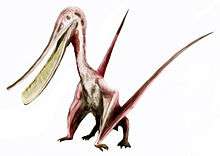 Pterodaustro guinazui | ||||
References
- Gini-Newman, Garfield; Graham, Elizabeth (2001). Echoes from the past: world history to the 16th century. Toronto: McGraw-Hill Ryerson Ltd. ISBN 9780070887398. OCLC 46769716.
- Fujiyama, I. (1970). "Fossil insects from the Chojabaru Formation, Iki Island, Japan". Memoires of the Natural Science Museum, Tokyo. 3: 65–74.
- Archibald, SB (2010). "Revision of the scorpionfly family Holcorpidae (Mecoptera), with description of a new species from Early Eocene McAbee, British Columbia, Canada" (PDF). Annales de la Société Entomologique de France. 46 (1–2): 173–182. doi:10.1080/00379271.2010.10697654.
- Sharov, A.G. 1970. A peculiar reptile from the Lower Triassic of Fergana. Paleontologiceskij Zurnal 1: pp. 127-130.
- Olshevsky, George. "Dinogeorge's Dinosaur Genera List". Retrieved 2008-08-07.
- Russell, D.A. 1970. Tyrannosaurs from the Late Cretaceous of Western Canada. National Museum of Nat. Sci., Publ. Paleontology No. 1.
- Osmolska, H. and E. Roniewicz. 1970. Deinocheiridae, a new family of theropod dinosaurs. Palaeontol. Polonica 21: pp. 5-19.
- Welles, S.P. 1970. Dilophosaurus (Reptilia: Saurischia), a new name for a dinosaur. J. Paleontol. 44: p. 989.
- Ellenberger, P. 1970. Les niveaux Paleontologiques de premiere apparition des Mammiferes primordiaux ed afrique du sud et leur ichnologie, establissement de zones stratigaphiques detaillees dans le stormberg du Lesotho (Afrique du sud) (Trias superieur a Jurassique). Proceedings Papers of the 2nd Gondwana Symposium in South Africa, 1970: pp. 343-370.
- Brown vide Ostrom, J.H. 1970. Terrestrial vertebrates as indicators of Mesozoic climates. Proc. North. Am. Paleontol. Convention D, 347-376.
- Ostrom, J.H. 1970. Stratigraphy and paleontology of the Cloverly Formation (Lower Cretaceous) of the Bighorn Basin area, Wyoming and Montana. Peabody Museum Nat. History Bull. 35: pp. 1-234.
- Colbert, E.H. 1970. A saurischian dinosaur from the Triassic of Brasil. Amer. Mus. Novitates 2405: pp. 1-39.
- Short, LL (1970). "A New Anseriform Genus and Species from the Nebraska Pliocene" (PDF). Auk. 87 (3): 537–543. doi:10.2307/4083796.
- Livezey; BC (1997). "A Phylogenetic Classification of Waterfowl (Aves: Anseriformes), including selected fossil species". Annals of Carnegie Museum. 66: 457–496.
- Arredondo, O (1970). "Nueva Especie de Ave Pleistocénica del Orden Accipitriformes (Accipitridae) y Nuevo Género para las Antillas". Ciencias, series 4 (Ciencias Biológicas). 8: 1–8.
- Duque, WS; Olson, SL (2007). "The Cuban Fossil Eagle Aquila borrasi Arredondo: A Scaled-up Version of the Great Black-hawk (Buteogallus urubitinga) (Gmelin)" (PDF). Journal of Raptor Research. 41 (4): 288–298. doi:10.3356/0892-1016(2007)41[288:tcfeab]2.0.co;2.
- George G. Simpson (1970). "Miocene Penguins from Victoria, Australia, and Chubut, Argentina" (PDF). Memoirs of the National Museum of Victoria. 31: 17–23. Archived from the original (PDF) on 2014-10-30. Retrieved 2014-10-30.
- Carolina Acosta Hospitaleche (2007). "Revisión Sistematicá de Palaeospheniscus biloculata (Simpson) nov. comb. (Aves, Spheniscidae) de la Formación Gaiman (Mioceno Temprano), Chubut, Argentina". Ameghiniana. 44 (2): 417–426.
- Hildegarde Howard (1970). "A Review of the Extinct Avian Genus Mancalla" (PDF). Museum of Natural History of Los Angeles County, Contributions in Science. 203: 1–12.
- Pierce Brodkorb (1970). "An Eocene Puffbird from Wyoming". Contributions to Geology University of Wyoming. 9 (1): 13–15. Archived from the original on 2016-08-07. Retrieved 2014-10-30.
- J. Alan Feduccia & Larry D. Martin (1976). "The Eocene Zygodactyl Birds of North America (Aves: Piciformes)" (PDF). In Collected Papers in Avian Paleontology Honoring the 90th Birthday of Alexander Wetmore ed.: Storrs. L. Olson; Smithsonian Contributions to Paleobiology. 27: 101–110.
- Larry D. Martin & James Tate, Jr. (1970). "A New Turkey from the Pliocene of Nebraska" (PDF). Wilson Bulletin. 82 (2): 214–218.
- J. Alan Feduccia (1970). "A New Shorebird from the Upper Pliocene" (PDF). Journal of the Graduate Research Center (Dallas, Texas). 38 (3–4): 58–60.
- Eduardo P. Tonni (1970). "Zonotrichia robusta n. sp. (Aves, Passeriformes) del Pleistoceno Medio de la Provincia de Buenos Aires". Ameghiniana. 7 (2): 161–165.

